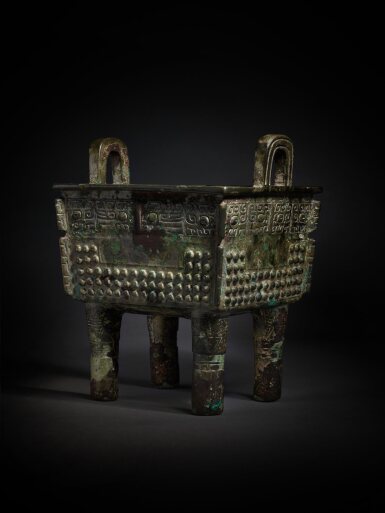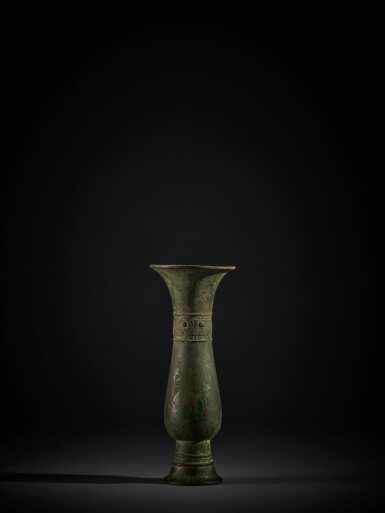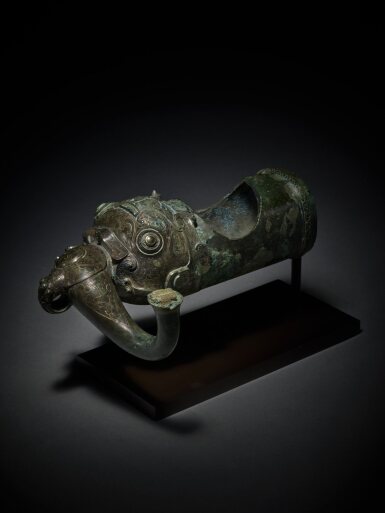DescriptionA superb malachite and copper-inlaid bronze vessel and cover (Fang Hu)Eastern Zhou dynasty, Warring States period東周 戰國 青銅嵌孔雀石錯銅龍紋方壺
(2)
Height 19⅞ in., 50.6 cmCondition reportThe vessel has a small break to the loose ring of one handle, and some minor losses to the inlay. The cover has a few tiny apertures to the top. Otherwise, both the vessel and cover are in overall good condition with some expected wear and surface encrustations.方壺一活環見一處小斷損。嵌飾見些許輕微缺失。蓋頂見幾處微細小孔。除此外,器及蓋均整體品相良好,見些許正常磨損及表面鏽斑。
For more information on and additional videos for this lot, please contact serina.wei@sothebys.com.ProvenanceGisèle Croës, New York, 1998.
吉賽爾,紐約,1998年ExhibitedFrom Archaic Ritual Bronzes to Tang Tomb Figures. This Life and the After-Life Part Two, Gisèle Croës, New York, 1997, pl. 42.
《From Archaic Ritual Bronzes to Tang Tomb Figures. This Life and the After-Life Part Two》,吉賽爾,紐約,1997年,圖版42Catalogue noteLavish Surface Ornamentation of the Warring States: A Magnificent Inlaid Fang Hu
Richly ornamented with horizontally-arranged geometric friezes outlined with copper wire and strips, and partially filled with small malachite chips, the present ritual vessel, fang hu, is a testament to the lavish bronze culture of the Warring States period (480-222 BC) of the Eastern Zhou dynasty (770-221 BC).
As with preceding periods of China's bronze age, ritual bronze vessels were of very high importance in Zhou society and were used during sacrificial ceremonies to offer food and wine to ancestors to obtain their protection. As the offerings were subsequently jointly consumed at ritual banquets, they also served to bond family clans. A vessel such as the present fang hu might have been used to contain wine in such ceremonies that were held at ancestral temples.
Ritual bronze vessels during this period generally adopted relatively simple forms, gradually losing the high cast relief decoration, elaborate flanges and zoomorphic forms seen on bronzes of the earlier Shang and Western Zhou periods; meanwhile their surfaces were gradually ornamented with visually dazzling geometric designs. With clever use of the techniques for inlaying different materials, the craftsmen enriched the monochrome bronze surface to create a unique multi-colored design.
Inlaid bronzes were first produced during the Spring and Autumn period (770-476 BC). While the early copper inlays that were added to the mold before the bronzes were cast were limited to simple designs and silhouettes, more vivid designs were soon created by incising the bronze after casting and filling the grooves with precious and semi-precious stones, such as turquoise and malachite.
The geometric designs found on bronzes of this period are thought to have been inspired by the fluid designs found on contemporaneous lacquer, which gained great popularity during this period. Early Warring States lacquerwares derived many of their decorative motifs, primarily interlaced designs, from bronze art. See, for example the painted lacquer dou from the early Warring States period, circa 433 BC, discovered in the tomb of Marquis Yi at Leigudun, Suxian, Hubei province, illustrated in The Golden Age of Chinese Archaeology. Celebrated Discoveries from the People's Republic of China, National Gallery of Art, Washington, D.C., 1999, cat. no. 108. However, by the mid-Warring States period, many new motifs in lacquer had emerged and, especially in the south, a curvilinear style gradually prevailed, demonstrated by fluid inlay designs, such as those seen on an inlaid bronze dou discovered in Fenshuiling, Changzhi, Shanxi province, illustrated in Wu Hung, 'The Art and Architecture of the Warring States Period,' Michael Loewe and Edward L. Shaughnessy (eds.), The Cambridge History of Ancient China. From the Origins of Civilization to 221 B.C., Cambridge, 1999, p. 683, fig. 10.13.
The present fang hu belongs to an impressive array of bronze vessels, each brilliantly inlaid with abstract designs arranged in horizontal registers. Compare the famous copper-inlaid fang hu excavated from the burial grounds of the kings of the state of Zhongshan in Hebei, Pingshan Sanji Gongshe at Zhongshan, now in the Tokyo National Museum, Tokyo, illustrated Wu Hung, ibid., p. 684, fig. 10.14 and Jenny So, Eastern Zhou Ritual Bronzes from the Arthur M. Sackler Collection, New York, 1995, fig. 109. Another fang hu, although missing its original inlay, formerly in the collection of Alfred F. Pillsbury and now in the Minneapolis Institute of Arts, Minneapolis (accession no. 50.46.98), is illustrated in Max Loehr, Ritual Vessels of Bronze Age China, New York, 1968, pl. 70. Two very similar bronze fang hu inlaid with diagonally oriented geometric patterns arranged on a central axis are also known. The first, reportedly excavated near Yulin fu, Shaanxi, in 1913, now in the National Gallery of Asian Art, Washington, D.C., gifted by Eugene and Agnes E. Meyer in 1961, is illustrated in the catalogue Chinese Art of the Warring States Period. Change and Continuity, 480-222 B.C., Freer Gallery of Art, Washington, D.C., 1982, cat. no. 7; the second, discovered in 1957 in Hunan province is illustrated in An Exhibition of Archaeological Finds from the People's Republic of China, Tokyo, 1977, cat. no. 42. Another in the Meiyintang Collection, with the body inlaid with an ornament on the body arranged by crossed diagonal bands is illustrated in Wang Tao, Chinese Bronzes from the Meiyintang Collection, London, 2009, pl. 47.
Perhaps the most famous example of an inlaid fang hu from the period is the documentary 'Chen Zhang' fang hu, acquired from C.T. Loo in 1916 and now in the University Museum, University of Pennsylvania, bearing a twenty-nine-character inscription at the foot recording that the bronze was obtained from the Yan state by a Qi general, Chen Zhang (also known as Tian Zhang, Zhangzi and Kuang Zhang) during a military assault in 315 BC, included in the exhibition Chinese Bronzes of the Shang Through the Tang Dynasty, Metropolitan Museum of Art, New York, 1938, cat. no. 185, and further discussed in Yang Hua and Gilbert K. Mattos, 'The Chen Zhang Fanghu', Orientations, vol. 32, no. 2, p. 57. Of similar design is an inlaid fang hu from the famous 'Jincun' finds near Luoyang in Henan, illustrated in William Charles White, Tombs of Old Lo-yang, Shanghai, 1934, pl. 109. Compare also a similar design inlaid in copper and malachite found on a bronze dui from the Winthrop Collection, gifted to the Fogg Art Museum in 1943, and now in the Harvard Art Museums, Cambridge (accession no. 1943.52.115), illustrated Jenny So, op. cit., p. 201, fig. 29.8.
Very few inlaid fang hu from the Warring States have appeared at auction. Compare one with a similar 'zigzag' design at the shoulder, included in the exhibition Chinese Art of the Warring States Period, Osaka Municipal Museum of Art, Osaka, 1991, cat. no. 169, sold in these rooms, 11th September 2012, lot 100. A rare 'figural' bronze fang hu, possibly slightly earlier in date and with only traces of the inlay remaining, was sold at Christie's New York, 24th March 2022, lot 719. An inlaid fang hu with the addition of gilt bosses was deaccessioned by the Albright Knox Museum in Buffalo, New York, and sold in these rooms, 20th March 2007, lot 508. Perhaps the most famous example sold at auction in recent years is the 'Stoclet' fang hu, with gilt, silver and glass inlay, previously in the collection of Adolphe Stoclet and included in the International Exhibition of Chinese Art, Royal Academy of Arts, London, 1935, cat. no. 406, sold in these rooms, 23rd September 2020, lot 578.
周禮華彝:青銅嵌孔雀石錯銅龍紋方壺
此方壺華飾繁縟,錯銅幾何紋橫貫器身,並鑲嵌細小孔雀石,足見東周戰國時期精湛卓絕的青銅器鑄造工藝。
青銅禮器早於周朝就已深受重視。古人在祭祀時用禮器盛載食物與酒供奉祖先,祈求庇陰。儀式過後,眾人一同享用祭品,因此祭祀亦有家族聯誼之效。如本品之方壺,或為過去宗廟祭祀儀式的盛酒器。
戰國時期的青銅禮器外形大多較為簡單。商、周時期深峻的浮雕、精美的扉棱和獸面紋逐漸消失,取而代之的是引人注目的幾何紋樣。工匠以高超的技藝巧鑲不同物料,在色澤單一的青銅器表面鋪排出獨一無二的設計。
錯嵌青銅器始見於春秋時期。早期工藝是於鑄造前在模具中加入銅飾,因此只局限於簡單的形制。後來的製法則是在成器表面的凹槽裡嵌入銅飾,或填進寶石,如綠松石、孔雀石等,整體外觀更加富麗典雅。
漆器在戰國時期非常流行,其華麗的圖案可能影響了青銅器的幾何紋飾。戰國初期,漆器上的交錯紋樣很多時候借鑒自青銅器,參見出土於湖北隨縣擂鼓墩曾侯乙墓的戰國初期(約公元前433年)漆豆,載圖於《The Golden Age of Chinese Archaeology. Celebrated Discoveries from the People’s Republic of China》,美國國家美術館,華盛頓,1999年,編號108。然而,到了戰國中期,尤其是在南方,以優美曲線和鑲嵌工藝為主的新式紋樣在漆器中開始湧現,並且此新式紋樣也可在同時期的青銅器找到。例如,出土於山西長治分水嶺的青銅錯金豆,錄於巫鴻、魯惟一及夏含夷合編,〈The Art and Architecture of the Warring States Period〉,《The Cambridge History of Ancient China. From the Origins of Civilization to 221 B.C.》,劍橋,1999年,頁683,圖10.13。
本品出自一組青銅佳器瑰藏,以細膩的錯嵌工藝在壺身橫紋寬帶上組成抽象圖案為點綴。相近作例可見中山王方壺,出土於中山國王一號墓,現藏於東京國立博物館,錄於巫鴻等人作,前述出處,頁684,圖10.14。兩件相似的方壺,錄於蘇芳淑,《Eastern Zhou Ritual Bronzes from the Arthur M. Sackler Collections》,卷III,紐約,1995年,圖109及112。另一例參照,鑲嵌的金石雖缺失,壺身同樣隔飾橫紋,屬 Alfred F. Pillsbury 舊藏,現藏於明尼阿波利斯美術館,編號50.46.98,錄於羅樾,《Ritual Vessels of Bronze Age China》,紐約,1968年,圖版70。再有兩件青銅方壺,壺身斜嵌菱形紋,其一據報出土於1913年陝西榆林府附近,現藏於美國亞洲藝術博物館,由 Eugene 及 Agnes E. Meyer 伉儷捐贈,載於圖錄《Chinese Art of the Warring States Period. Change and Continuity, 480-222 B.C.》,華盛頓弗利爾美術館,1982年,編號7,其二,1957年在湖南被發現,載於《中華人民共和國出土文物展》,東京,1977年,編號42。另一近例為玫茵堂藏幾何紋方壺,載於汪濤,《玫茵堂藏中國銅器》,倫敦,2009年,圖版47。
陳璋方壺也許是最廣為人知的戰國時期方壺,1916年從盧芹齋手上購入,現存位於費城的賓夕法尼亞大學博物館。壺足刻二十九字銘文,記載此壺由齊國將軍陳璋(又名田章、章子或匡章)在齊宣王五年(公元前315年)攻打燕國時所得。此壺曾展於《Chinese Bronzes of the Shang Through the Tang Dynasty》,紐約大都會藝術博物館,1938年,編號185,記載於 Yang Hua 及馬幾道,〈The Chen Zhang Fanghu〉,《Orientations》,卷32,期2,頁57。另見一件在河南洛陽金村出土的青銅方壺,外觀與本品相近,錄於懷履光,《洛陽古城古墓考》,上海,1934年,圖版109。
此外亦可參考溫索浦舊藏青銅敦,錯銅嵌孔雀石,所採用之工藝與本品類近,1943年贈予福格藝術博物館,現藏於哈佛藝術博物館,編號1943.52.115,收錄於蘇芳淑,前述出處,頁201,圖29.8。
以往絕少有戰國時期的錯嵌青銅方壺現身拍賣會。有一肩飾菱形方格紋之錯金鑲孔雀石方壺,曾展於《中国戦国時代の美術》,大阪市立美術館,1991年,編號169,售於紐約蘇富比,2012年9月11日,編號100。另有罕見宴樂狩獵水陸攻戰紋方壺,年代較本品略早,壺身鑲嵌金石所剩無幾,售於紐約佳士得,2022年3月24日,編號719。另可參考一鎏金乳釘紋方壺,紐約水牛城奧爾布賴特-諾克斯美術館(簡稱奧諾美術館)舊藏,售於紐約蘇富比,2007年3月20日,編號508。而近年在拍賣會成交最著名的方壺必屬 Adolphe Stoclet 舊藏的青銅錯金銀嵌琉璃乳釘紋方壺,曾展於《中國藝術國際展覽會》,倫敦皇家藝術學院,1935年,編號406,售於紐約蘇富比,2020年9月23日,編號578。
DescriptionA superb malachite and copper-inlaid bronze vessel and cover (Fang Hu)Eastern Zhou dynasty, Warring States period東周 戰國 青銅嵌孔雀石錯銅龍紋方壺
(2)
Height 19⅞ in., 50.6 cmCondition reportThe vessel has a small break to the loose ring of one handle, and some minor losses to the inlay. The cover has a few tiny apertures to the top. Otherwise, both the vessel and cover are in overall good condition with some expected wear and surface encrustations.方壺一活環見一處小斷損。嵌飾見些許輕微缺失。蓋頂見幾處微細小孔。除此外,器及蓋均整體品相良好,見些許正常磨損及表面鏽斑。
For more information on and additional videos for this lot, please contact serina.wei@sothebys.com.ProvenanceGisèle Croës, New York, 1998.
吉賽爾,紐約,1998年ExhibitedFrom Archaic Ritual Bronzes to Tang Tomb Figures. This Life and the After-Life Part Two, Gisèle Croës, New York, 1997, pl. 42.
《From Archaic Ritual Bronzes to Tang Tomb Figures. This Life and the After-Life Part Two》,吉賽爾,紐約,1997年,圖版42Catalogue noteLavish Surface Ornamentation of the Warring States: A Magnificent Inlaid Fang Hu
Richly ornamented with horizontally-arranged geometric friezes outlined with copper wire and strips, and partially filled with small malachite chips, the present ritual vessel, fang hu, is a testament to the lavish bronze culture of the Warring States period (480-222 BC) of the Eastern Zhou dynasty (770-221 BC).
As with preceding periods of China's bronze age, ritual bronze vessels were of very high importance in Zhou society and were used during sacrificial ceremonies to offer food and wine to ancestors to obtain their protection. As the offerings were subsequently jointly consumed at ritual banquets, they also served to bond family clans. A vessel such as the present fang hu might have been used to contain wine in such ceremonies that were held at ancestral temples.
Ritual bronze vessels during this period generally adopted relatively simple forms, gradually losing the high cast relief decoration, elaborate flanges and zoomorphic forms seen on bronzes of the earlier Shang and Western Zhou periods; meanwhile their surfaces were gradually ornamented with visually dazzling geometric designs. With clever use of the techniques for inlaying different materials, the craftsmen enriched the monochrome bronze surface to create a unique multi-colored design.
Inlaid bronzes were first produced during the Spring and Autumn period (770-476 BC). While the early copper inlays that were added to the mold before the bronzes were cast were limited to simple designs and silhouettes, more vivid designs were soon created by incising the bronze after casting and filling the grooves with precious and semi-precious stones, such as turquoise and malachite.
The geometric designs found on bronzes of this period are thought to have been inspired by the fluid designs found on contemporaneous lacquer, which gained great popularity during this period. Early Warring States lacquerwares derived many of their decorative motifs, primarily interlaced designs, from bronze art. See, for example the painted lacquer dou from the early Warring States period, circa 433 BC, discovered in the tomb of Marquis Yi at Leigudun, Suxian, Hubei province, illustrated in The Golden Age of Chinese Archaeology. Celebrated Discoveries from the People's Republic of China, National Gallery of Art, Washington, D.C., 1999, cat. no. 108. However, by the mid-Warring States period, many new motifs in lacquer had emerged and, especially in the south, a curvilinear style gradually prevailed, demonstrated by fluid inlay designs, such as those seen on an inlaid bronze dou discovered in Fenshuiling, Changzhi, Shanxi province, illustrated in Wu Hung, 'The Art and Architecture of the Warring States Period,' Michael Loewe and Edward L. Shaughnessy (eds.), The Cambridge History of Ancient China. From the Origins of Civilization to 221 B.C., Cambridge, 1999, p. 683, fig. 10.13.
The present fang hu belongs to an impressive array of bronze vessels, each brilliantly inlaid with abstract designs arranged in horizontal registers. Compare the famous copper-inlaid fang hu excavated from the burial grounds of the kings of the state of Zhongshan in Hebei, Pingshan Sanji Gongshe at Zhongshan, now in the Tokyo National Museum, Tokyo, illustrated Wu Hung, ibid., p. 684, fig. 10.14 and Jenny So, Eastern Zhou Ritual Bronzes from the Arthur M. Sackler Collection, New York, 1995, fig. 109. Another fang hu, although missing its original inlay, formerly in the collection of Alfred F. Pillsbury and now in the Minneapolis Institute of Arts, Minneapolis (accession no. 50.46.98), is illustrated in Max Loehr, Ritual Vessels of Bronze Age China, New York, 1968, pl. 70. Two very similar bronze fang hu inlaid with diagonally oriented geometric patterns arranged on a central axis are also known. The first, reportedly excavated near Yulin fu, Shaanxi, in 1913, now in the National Gallery of Asian Art, Washington, D.C., gifted by Eugene and Agnes E. Meyer in 1961, is illustrated in the catalogue Chinese Art of the Warring States Period. Change and Continuity, 480-222 B.C., Freer Gallery of Art, Washington, D.C., 1982, cat. no. 7; the second, discovered in 1957 in Hunan province is illustrated in An Exhibition of Archaeological Finds from the People's Republic of China, Tokyo, 1977, cat. no. 42. Another in the Meiyintang Collection, with the body inlaid with an ornament on the body arranged by crossed diagonal bands is illustrated in Wang Tao, Chinese Bronzes from the Meiyintang Collection, London, 2009, pl. 47.
Perhaps the most famous example of an inlaid fang hu from the period is the documentary 'Chen Zhang' fang hu, acquired from C.T. Loo in 1916 and now in the University Museum, University of Pennsylvania, bearing a twenty-nine-character inscription at the foot recording that the bronze was obtained from the Yan state by a Qi general, Chen Zhang (also known as Tian Zhang, Zhangzi and Kuang Zhang) during a military assault in 315 BC, included in the exhibition Chinese Bronzes of the Shang Through the Tang Dynasty, Metropolitan Museum of Art, New York, 1938, cat. no. 185, and further discussed in Yang Hua and Gilbert K. Mattos, 'The Chen Zhang Fanghu', Orientations, vol. 32, no. 2, p. 57. Of similar design is an inlaid fang hu from the famous 'Jincun' finds near Luoyang in Henan, illustrated in William Charles White, Tombs of Old Lo-yang, Shanghai, 1934, pl. 109. Compare also a similar design inlaid in copper and malachite found on a bronze dui from the Winthrop Collection, gifted to the Fogg Art Museum in 1943, and now in the Harvard Art Museums, Cambridge (accession no. 1943.52.115), illustrated Jenny So, op. cit., p. 201, fig. 29.8.
Very few inlaid fang hu from the Warring States have appeared at auction. Compare one with a similar 'zigzag' design at the shoulder, included in the exhibition Chinese Art of the Warring States Period, Osaka Municipal Museum of Art, Osaka, 1991, cat. no. 169, sold in these rooms, 11th September 2012, lot 100. A rare 'figural' bronze fang hu, possibly slightly earlier in date and with only traces of the inlay remaining, was sold at Christie's New York, 24th March 2022, lot 719. An inlaid fang hu with the addition of gilt bosses was deaccessioned by the Albright Knox Museum in Buffalo, New York, and sold in these rooms, 20th March 2007, lot 508. Perhaps the most famous example sold at auction in recent years is the 'Stoclet' fang hu, with gilt, silver and glass inlay, previously in the collection of Adolphe Stoclet and included in the International Exhibition of Chinese Art, Royal Academy of Arts, London, 1935, cat. no. 406, sold in these rooms, 23rd September 2020, lot 578.
周禮華彝:青銅嵌孔雀石錯銅龍紋方壺
此方壺華飾繁縟,錯銅幾何紋橫貫器身,並鑲嵌細小孔雀石,足見東周戰國時期精湛卓絕的青銅器鑄造工藝。
青銅禮器早於周朝就已深受重視。古人在祭祀時用禮器盛載食物與酒供奉祖先,祈求庇陰。儀式過後,眾人一同享用祭品,因此祭祀亦有家族聯誼之效。如本品之方壺,或為過去宗廟祭祀儀式的盛酒器。
戰國時期的青銅禮器外形大多較為簡單。商、周時期深峻的浮雕、精美的扉棱和獸面紋逐漸消失,取而代之的是引人注目的幾何紋樣。工匠以高超的技藝巧鑲不同物料,在色澤單一的青銅器表面鋪排出獨一無二的設計。
錯嵌青銅器始見於春秋時期。早期工藝是於鑄造前在模具中加入銅飾,因此只局限於簡單的形制。後來的製法則是在成器表面的凹槽裡嵌入銅飾,或填進寶石,如綠松石、孔雀石等,整體外觀更加富麗典雅。
漆器在戰國時期非常流行,其華麗的圖案可能影響了青銅器的幾何紋飾。戰國初期,漆器上的交錯紋樣很多時候借鑒自青銅器,參見出土於湖北隨縣擂鼓墩曾侯乙墓的戰國初期(約公元前433年)漆豆,載圖於《The Golden Age of Chinese Archaeology. Celebrated Discoveries from the People’s Republic of China》,美國國家美術館,華盛頓,1999年,編號108。然而,到了戰國中期,尤其是在南方,以優美曲線和鑲嵌工藝為主的新式紋樣在漆器中開始湧現,並且此新式紋樣也可在同時期的青銅器找到。例如,出土於山西長治分水嶺的青銅錯金豆,錄於巫鴻、魯惟一及夏含夷合編,〈The Art and Architecture of the Warring States Period〉,《The Cambridge History of Ancient China. From the Origins of Civilization to 221 B.C.》,劍橋,1999年,頁683,圖10.13。
本品出自一組青銅佳器瑰藏,以細膩的錯嵌工藝在壺身橫紋寬帶上組成抽象圖案為點綴。相近作例可見中山王方壺,出土於中山國王一號墓,現藏於東京國立博物館,錄於巫鴻等人作,前述出處,頁684,圖10.14。兩件相似的方壺,錄於蘇芳淑,《Eastern Zhou Ritual Bronzes from the Arthur M. Sackler Collections》,卷III,紐約,1995年,圖109及112。另一例參照,鑲嵌的金石雖缺失,壺身同樣隔飾橫紋,屬 Alfred F. Pillsbury 舊藏,現藏於明尼阿波利斯美術館,編號50.46.98,錄於羅樾,《Ritual Vessels of Bronze Age China》,紐約,1968年,圖版70。再有兩件青銅方壺,壺身斜嵌菱形紋,其一據報出土於1913年陝西榆林府附近,現藏於美國亞洲藝術博物館,由 Eugene 及 Agnes E. Meyer 伉儷捐贈,載於圖錄《Chinese Art of the Warring States Period. Change and Continuity, 480-222 B.C.》,華盛頓弗利爾美術館,1982年,編號7,其二,1957年在湖南被發現,載於《中華人民共和國出土文物展》,東京,1977年,編號42。另一近例為玫茵堂藏幾何紋方壺,載於汪濤,《玫茵堂藏中國銅器》,倫敦,2009年,圖版47。
陳璋方壺也許是最廣為人知的戰國時期方壺,1916年從盧芹齋手上購入,現存位於費城的賓夕法尼亞大學博物館。壺足刻二十九字銘文,記載此壺由齊國將軍陳璋(又名田章、章子或匡章)在齊宣王五年(公元前315年)攻打燕國時所得。此壺曾展於《Chinese Bronzes of the Shang Through the Tang Dynasty》,紐約大都會藝術博物館,1938年,編號185,記載於 Yang Hua 及馬幾道,〈The Chen Zhang Fanghu〉,《Orientations》,卷32,期2,頁57。另見一件在河南洛陽金村出土的青銅方壺,外觀與本品相近,錄於懷履光,《洛陽古城古墓考》,上海,1934年,圖版109。
此外亦可參考溫索浦舊藏青銅敦,錯銅嵌孔雀石,所採用之工藝與本品類近,1943年贈予福格藝術博物館,現藏於哈佛藝術博物館,編號1943.52.115,收錄於蘇芳淑,前述出處,頁201,圖29.8。
以往絕少有戰國時期的錯嵌青銅方壺現身拍賣會。有一肩飾菱形方格紋之錯金鑲孔雀石方壺,曾展於《中国戦国時代の美術》,大阪市立美術館,1991年,編號169,售於紐約蘇富比,2012年9月11日,編號100。另有罕見宴樂狩獵水陸攻戰紋方壺,年代較本品略早,壺身鑲嵌金石所剩無幾,售於紐約佳士得,2022年3月24日,編號719。另可參考一鎏金乳釘紋方壺,紐約水牛城奧爾布賴特-諾克斯美術館(簡稱奧諾美術館)舊藏,售於紐約蘇富比,2007年3月20日,編號508。而近年在拍賣會成交最著名的方壺必屬 Adolphe Stoclet 舊藏的青銅錯金銀嵌琉璃乳釘紋方壺,曾展於《中國藝術國際展覽會》,倫敦皇家藝術學院,1935年,編號406,售於紐約蘇富比,2020年9月23日,編號578。















Testen Sie LotSearch und seine Premium-Features 7 Tage - ohne Kosten!
Lassen Sie sich automatisch über neue Objekte in kommenden Auktionen benachrichtigen.
Suchauftrag anlegen